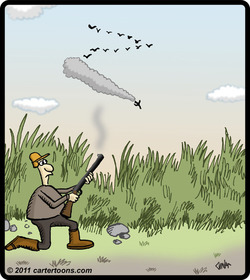Lucky Bird Hunter
 A stone is projected from a point on the ground, so as to hit a bird on the top of a vertical pole of height "h" and then attains a max height "2h" above the ground.
A stone is projected from a point on the ground, so as to hit a bird on the top of a vertical pole of height "h" and then attains a max height "2h" above the ground.
If at the instant of projection, the bird flies in the horizontal direction with a uniform speed and if the stone hits the bird while descending, the ratio of the speed of the bird to the horizontal speed of the stone can be represented as:
a/(b+c).
Find the value of a^2 + b^2 + c^2
The answer is 7.
This section requires Javascript.
You are seeing this because something didn't load right. We suggest you, (a) try
refreshing the page, (b) enabling javascript if it is disabled on your browser and,
finally, (c)
loading the
non-javascript version of this page
. We're sorry about the hassle.
2 solutions
The bird would be at a height h twice during it's motion. The total time from the point of projection to the point where stone and bird collide can be given by the bigger root of h = v 0 sin α t A B − 2 1 g t A B 2 Now, we know that v 0 sin α = 2 g h by writing its maximum height. Hence, substituting this in the first equation and solving quadratic gives us t A B = g 2 h ( 2 ± 1 ) . Of course, the total time from the point of projection to the point where stone and bird collide would be T = g 2 h ( 2 + 1 ) . Since the bird is moving with a constant velocity (Let it be v b ), we can write: v b R B D = T , where R B D is the distance the bird travels. This can of course be written as 2 v 0 cos α ⋅ g 2 h , considering it to be the range of a smaller projectile thrown with vertical velocity 2 g h and horizontal velocity v 0 cos α . Now, using v b R B D = T , we get
v b v 0 cos α = 2 + 1 2
Let Vy be the vertical component of the stone's velocity and Vx be it's horizontal velocity.
Max height = 2H = (Vy^2)/2g
Vy^2 = 4gH
Now, the time at which the stone reaches height H. There will be two such times. Let them be T and T', where T > T'.
H = (Vy)t - g(t^2)/2
Solutions of this are T, T'.
T = Vy + sqrt[Vy^2 - 2gH]/g
We need T - T' for the time between the 2 heights.
T - T' = 2sqrt{Vy^2 - 2gH}/g
Finally, (velocity of bird)/(Vx) = (T - T')/T = 2/[(sqrt2) + 1]
Sorry for non-formatting, I am unable to do so properly.